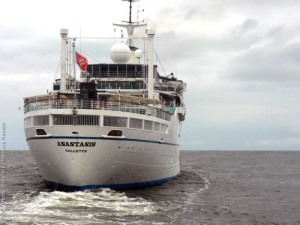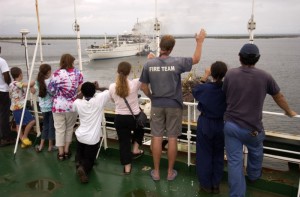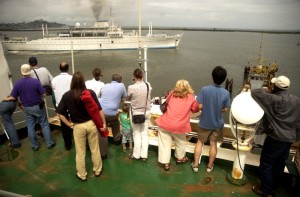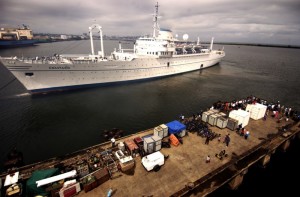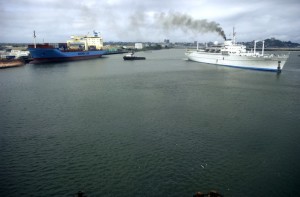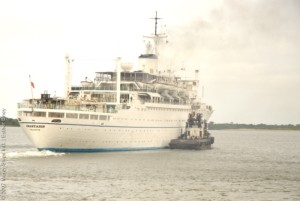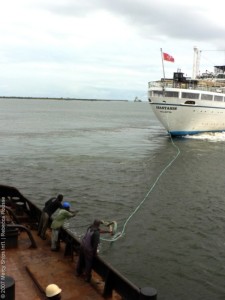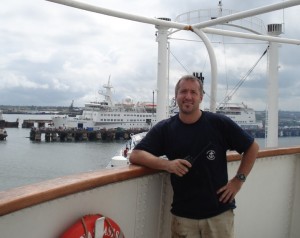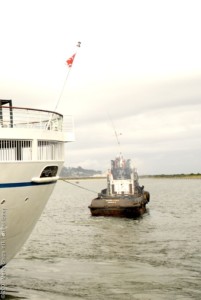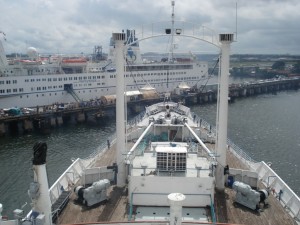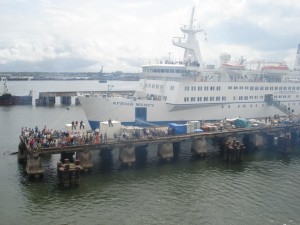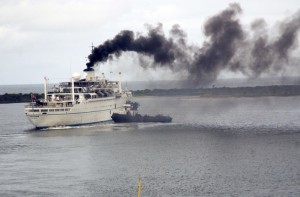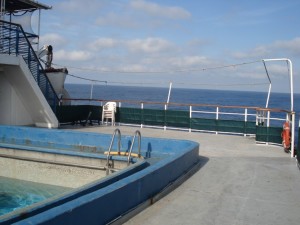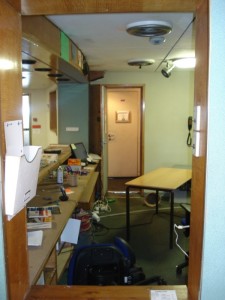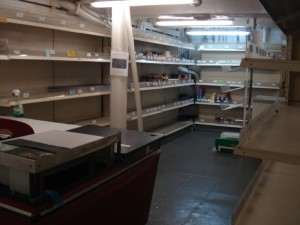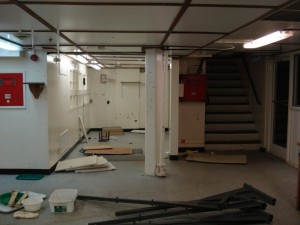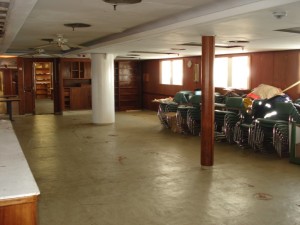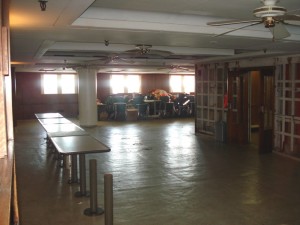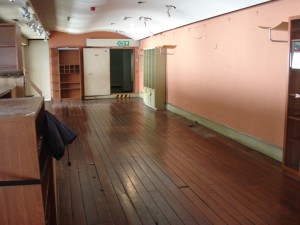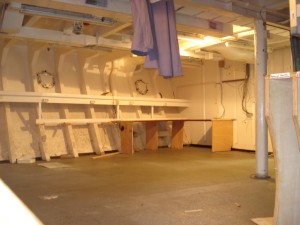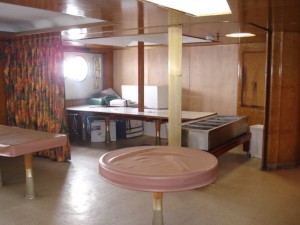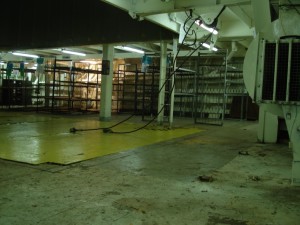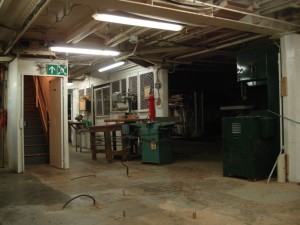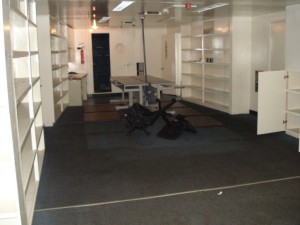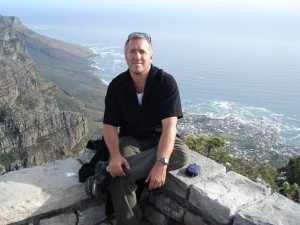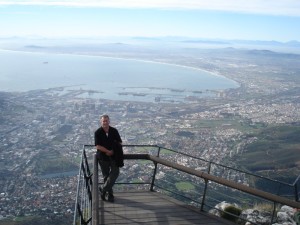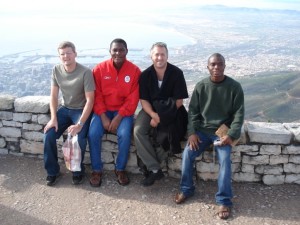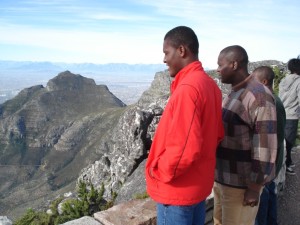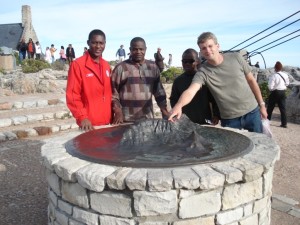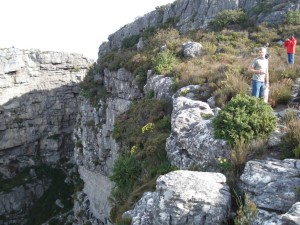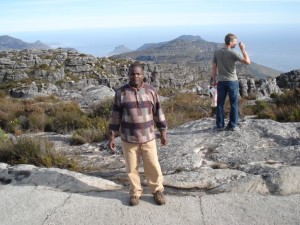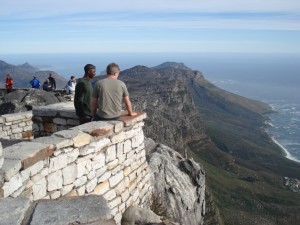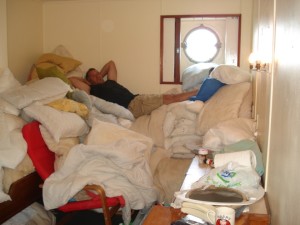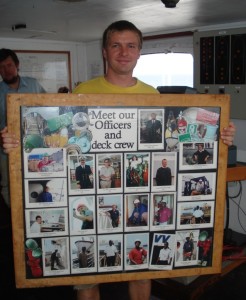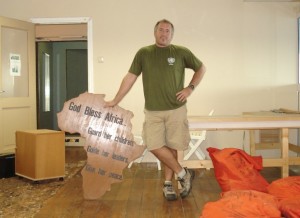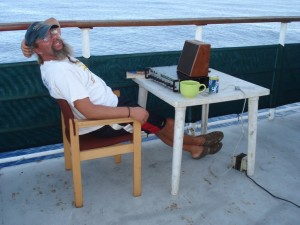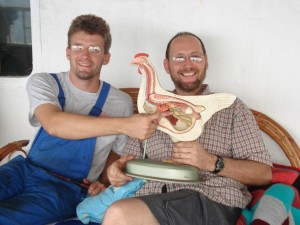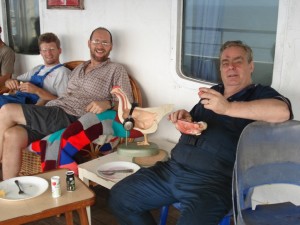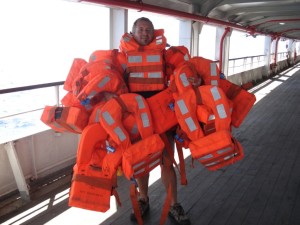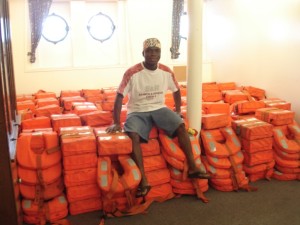The Final Sail of the Anastasis
–by Eric Thibodeau
 The Anastasis served as the flagship for Mercy Ships from 1978 until 2007. In June of this year, thirty-eight of us took it from it’s last port of call, Monrovia, Liberia, to it’s final resting place. This page is my record of that historic voyage. Thank you for your interest in this page, and for all those who served on the Anastasis throughout the years, thank you for your service, and God bless you.
The Anastasis served as the flagship for Mercy Ships from 1978 until 2007. In June of this year, thirty-eight of us took it from it’s last port of call, Monrovia, Liberia, to it’s final resting place. This page is my record of that historic voyage. Thank you for your interest in this page, and for all those who served on the Anastasis throughout the years, thank you for your service, and God bless you.
The following is a journal of the last sail of the m/v Anastasis as written by Eric Thibodeau.
More about Eric can be found at ericthibodeau.com Thanks Eric for writing this account to be remembered!
28 June-On the morning of the sail, Deck & Engineering Departments joined for one last devotion. Departmental devotions are held almost every morning on board, and once a week, Deck & Engineering have always joined together on the aft deck for devotions together. Today was the last time for that, and an open invitation for all other departments was extended, and they took us up on it. It was loud, it was joyous, & it was long. Nobody wanted it to end, but with a sharp, “OK, we got work to do!”, from The Africa Mercy’s bosun, Laurence Adjai, the crowd scattered and we began getting her ready for sea.
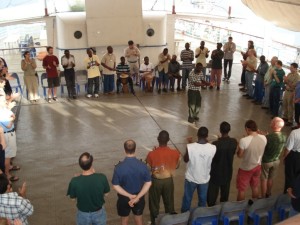
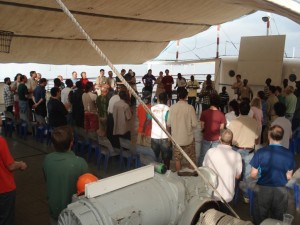
Of course, a good part of the morning was spent saying goodbye to everyone. Hardest for me was saying goodbye to Durga, Ragav, Rabi, and all my other friends from the Nepali camp next door, Jon & Terry Leischner, and my three Gurkha’s- Ganesh, Min, & Khim. The Leischners and the Gurkha’s both left for the airport about twenty minutes later as the ship was departing. The Leischner’s are bound for Oregon, and the Gurkha’s, of course, for their native Nepal.
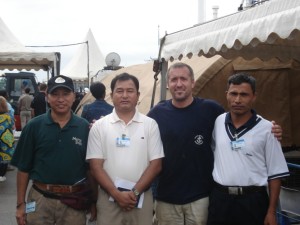
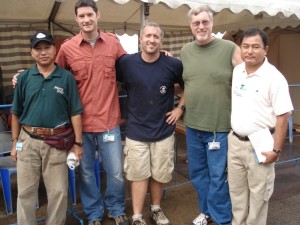
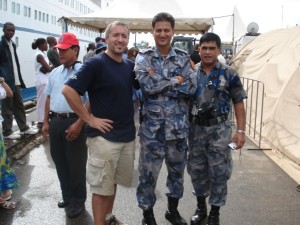
By 1000, we were ready to depart. With a helping hand from Marcel Eveleens ( who can never resist helping ) the gangway was removed and we singled up all of the lines. The crew of the Africa Mercy lined up along the dock to see us off and they were joined by Liberians, Ghanaian UNMIL troops, and my friends, the Nepali soldiers. So, we manned the rails and waved goodbye to everyone, many of whom we would never see again.
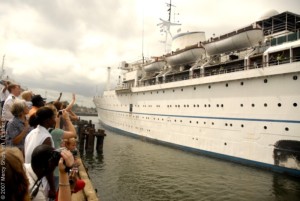
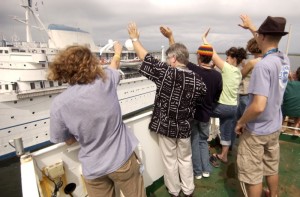
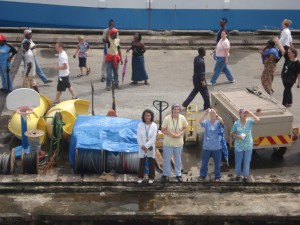
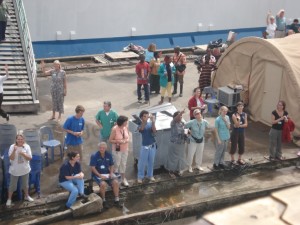
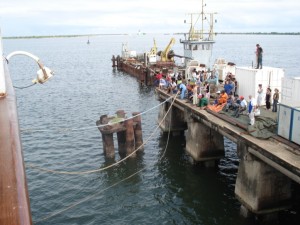
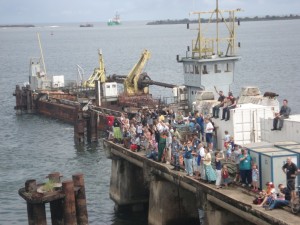
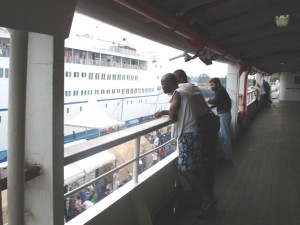
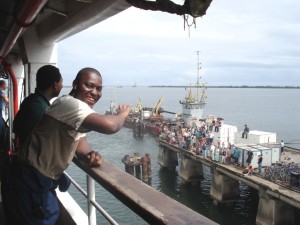
And so, we backed out and to the port, turning anti-clockwise until we were facing the breakwater, using the tug
for assistance. The crowd on the dock grew smaller and smaller as we steamed towards the entrance of the harbor.
As always, Monrovia’s tug, the Bushrod Island, was there to offer Mercy Ships it’s assistance. As the Pilot Boat sank last year, making it Monrovia’s twentieth (!!!) wreck, the Bushrod Island doubles as Freeport’s pilot boat, as well. On board the tug was a contingent of Mercy Shippers, who had the best view of the operation, especially those who braved the tugs exhaust to watch from atop the bridge.
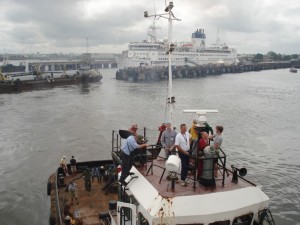
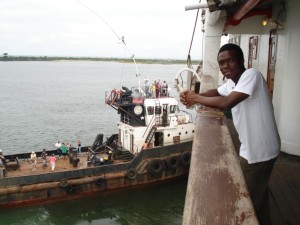
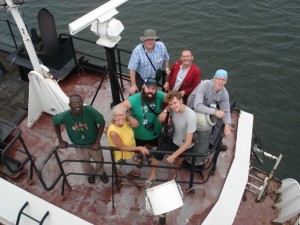
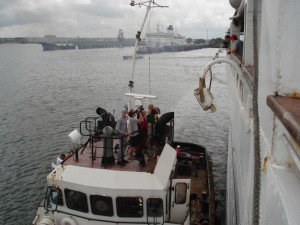
All too soon we were at the breakwater. The tug broke loose, we hit the throttle and away we went, India-bound. After getting the lines stowed, the loose items secured and all of the various workspaces ready for sea, everyone disappeared. It had already been a long day (compounded, no doubt, by the fact few had slept the night before), & we were all tired.
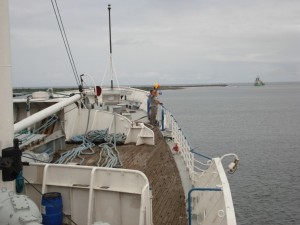
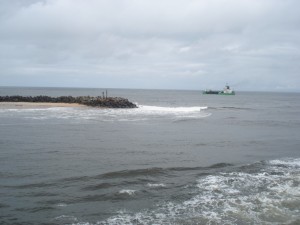
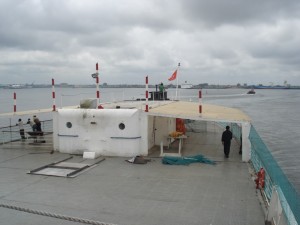
What struck all of us right away was the silence. If you’ve been onboard, you know how lively (some would say chaotic) the ship can be; with people constantly on the move, going from place to place, working, walking, talking, yelling and laughing. Even when you were on the night shift, there was always somebody else up and around working, talking, or just unable to sleep. The first few days of the Final Sail found a completely quiet ship, and the silence was eerie. The term ‘ghost ship’ was uttered a few times. With only three dozen on board and most of those either working or sleeping, no matter where you went on the ship, you were greeted with dead silence, the only sound being the distant hum of the engines. Back when the ship was operating, if you were feeling lonely or bored, you headed to the Med Lounge or the dining room, knowing there’d be a table full of people there, chattering away…maybe even a card game or two. Now, we found ourselves wandering, subconsciously wondering where everyone was. The lack of activity was strange…but being a seasoned Mercy Shipper, I wisely used the time to do my laundry-before anyone else had the same idea!
We quickly fell into our daily routines of watch keeping, day work, cooking and cleaning. Deck and engineering worked standard Four on/Eight off schedules, while the galley and housekeeping worked during the day. Audrey, Mike, Alberta and Theo made up our galley staff, while Dan Connors and I were in charge of deck day work, lashing down loose cargo, tightening the hatches, and making sure that the dozens of empty cabins, offices, holds, & storerooms were ready for the long voyage ahead. Here are some pictures of the ships’ crew members at work…
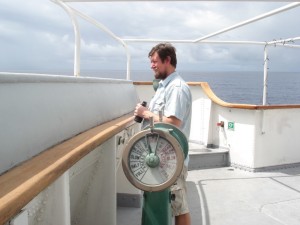
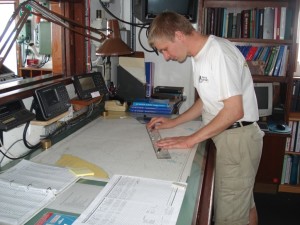
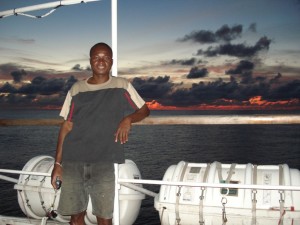
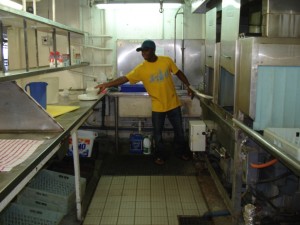
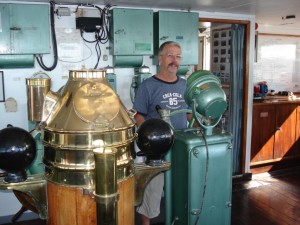
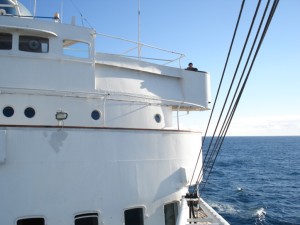
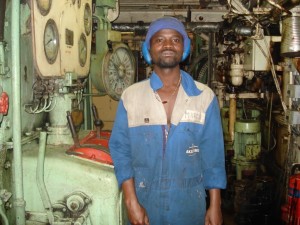
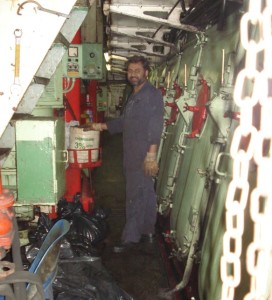
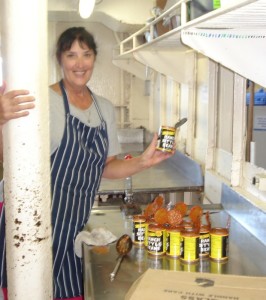
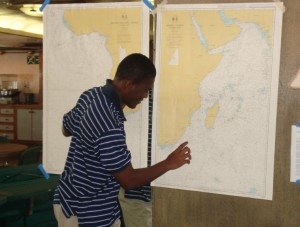
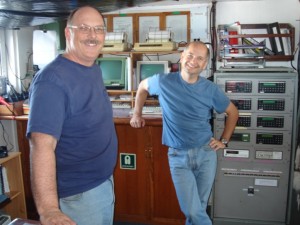
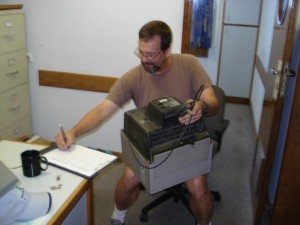
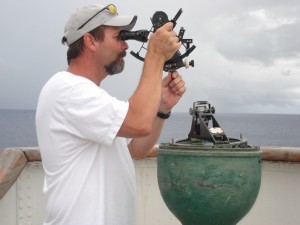
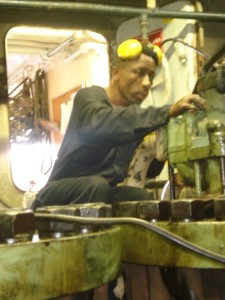
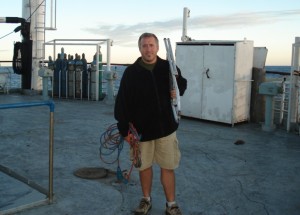
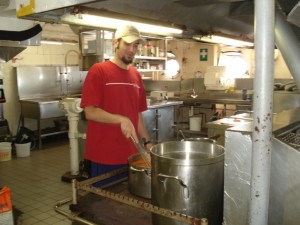
It wasn’t all work, of course. A lack of crew means a lot of empty spaces. It also means that there’s a whole lot of extra furniture lying around. Within the first couple of days, I dragged the chairs in the book shop out onto the promenade deck and threw us together a little ‘prom deck nook’, then copied it on the starboard side. Bowie found a couch in the CDS office & plunked it down next to the pool, which we’d kept full of water. The family room (and only TV) got a little crowded, so we turned the International lounge into a second TV lounge, using one of the four TV’s I found poking around the ship and a VCR that Dave had found in his room. The promenade deck ‘lounges’ were a big hit, and were in constant use; to watch sunsets, study the bible, or just to sit and relax. The Africa Room became Rodrigo’s ‘dart room’ & the Med Lounge usually had about three puzzles going at any given time.
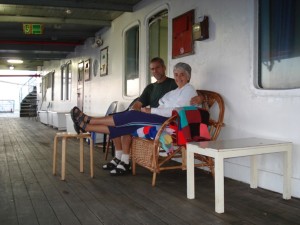
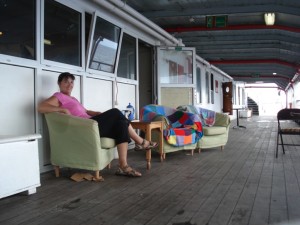
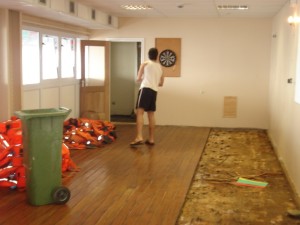
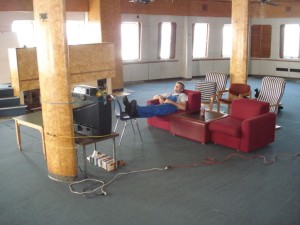
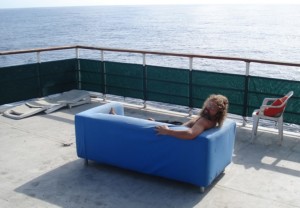
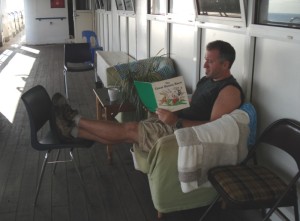
With the heat being what it was, and not having air conditioning, many of us opted to sleep in the ward or the OR, two spaces that kept the a/c running. People marked off their spaces quick, and all the rooms soon had things like ‘Micah Eaby’s house‘ or ‘Reserved for Richmond- Don’t even think about it’! scrawled on the doors. Most enterprising was Chief Engineer Pete Johnson, who dragged a bunk bed, rocking chair, & AC unit into the eye exam room next to his office and made himself a cabin. But these makeshift sleeping arrangements lasted less than a week. Within four days, the temperature had dropped enough for us to sleep in your own cabin. Three days later, we were all closing our portholes and doubling up our blankets against the cold. The cold weather lasted almost three weeks, & only began warming back up when we had a week to go to reach our destination. By that time, some had grown bored with sleeping in the spaces provided and chose their own places to sleep, all over the ship.
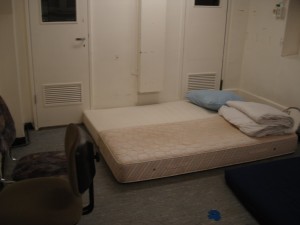
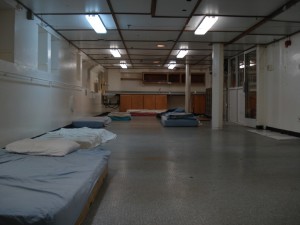
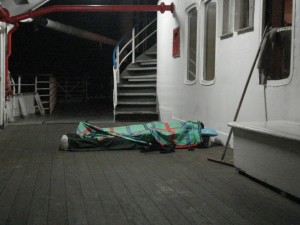
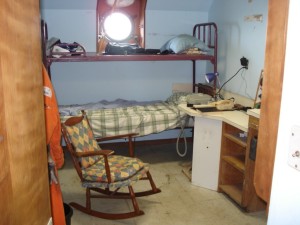
We passed over the Equator at 0649 on July 6th. I was sitting on the promenade deck reading quietly when the
word came on the overhead from Chief Officer Tim Trethaway. He announced that we were now passing over Equator right now, and if anyone would like to see the Equator line, they should look outside before we passed it. I chuckled to myself and went back to my book. Just then a door burst open and a crew member (who shall remain nameless) hurried over to the rail, scanning the sea left and right, frantically trying to spot it. He turned to me & asked, “Where is it?? Where is the line?” . It took me a couple minutes to explain the joke to him.
From an engineering standpoint, it wasn’t one of the better trips. We broke down a half-dozen or so times, drifting for a total of nine days. At 54, the old ship was already a couple decades past the age most ships have outlived their usefulness, & it showed. Despite the hard work by a very capable engineering staff, we were plagued by mechanical problems for the entire voyage, many of which stemmed from a load of bad fuel. Our engineers labored the whole trip, having to rebuild six high-pressure fuel pumps, replace twenty-eight fuel injectors, repair the boiler three times, changed one of the cylinder heads and removed water from the fuel, among other things. The piston rings were over-worn, fuel leaked into the lubricating oil of one of the generators, while bacteria began growing in the lubricating oil of another one. The last 2 weeks and 2000 miles we were forced to finish on one engine, as the starboard fuel pumps simply quit working. At bottom left is a picture of the port turning gear housing, which cracked a week after leaving Monrovia. The skill and devotion to duty of the engineers was unmatched on this trip.
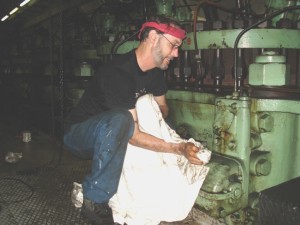
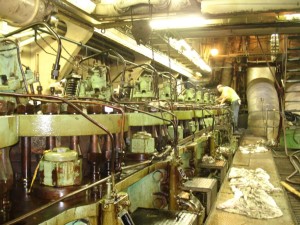
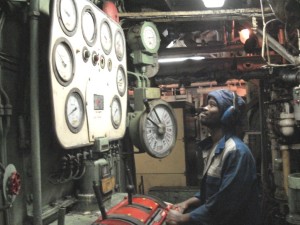
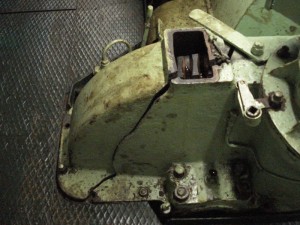
Although the engineers had got the boiler going, we’d already ordered some light oil to run the ship with, just in case. So, we drifted for a little while longer, as the tanker ‘Oceanview’ was on it’s way to us. At around 0900 on the morning of the fifth, it came alongside and we took on around 250 tons of light oil. Instead of coming alongside of us, the Oceanview actually passed us an 80 meter length of line which we put over our front bitts. They then passed a line with the hose attached back to us. After hooking up the hose at the starboard bunkering station, we gave them the go-ahead. We both crept ahead, connected by only a three-inch line and a 4-inch hose. We stayed like that for the six hours it took us to load the fuel. Not surprisingly, there was a fair amount of water mixed with the fuel. Tankers can pump in tons of water which is easily hidden; the fuel floats on top of the water, which will settle at the bottom of the tanks. If they add in 5% water, that’s an extra 5% profit for them, and by the time you realize, it’s already paid for & on your ship. It’s not uncommon, as these type of vessels tend to work the West African fishing fleet. Boats they service are generally made up of foreign crews (usually Chinese or Korean), thousands of miles from home, and aren’t really in a position to argue about the fuel they receive.
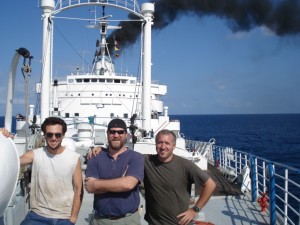
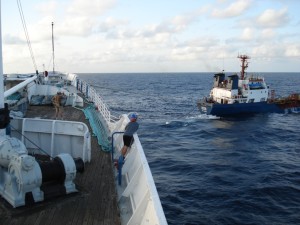
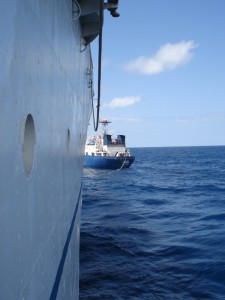
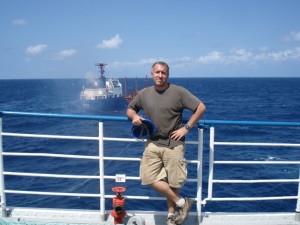
The engine room wasn’t the only part of the ship that experienced problems. As we went along, it seemed more and more problems kept popping up. Maybe it was the age of the ship (54) or the length of the voyage; at over 8000 miles, it was the longest trip the ship has seen since it’s days as a cruise liner. We had more things falling apart this trip than I’ve seen since I’ve been on board. The wind tore off the plastic sheeting roof on the aft deck, a section of the nursery deck roof fell down, much of the wallpaper began peeling off, and the ship many leaks bled rusty streaks onto the bulkheads all over the ship.
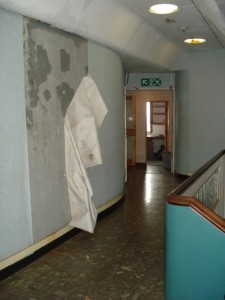
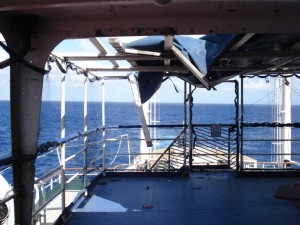
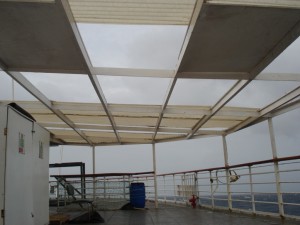
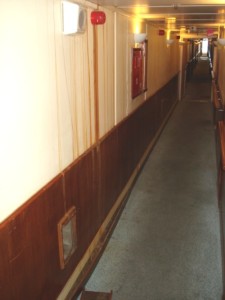
Unbeknownst to us, Africa Mercy had declined to take a large number of books that were donated. They’d already filled their library with the thousands of books that had been donated to them, and took only a fraction of the books that had lined the shelves of our ships library. I found them in the school all boxed up, over a hundred boxes in all. A rough count put the total number of books left behind at around five thousand. I spent a couple days re-boxing them and pulling out a couple hundred or so of the more popular ones. We put six boxes worth on an empty table in the galley, and the ‘Final Sail Library’ was born. It proved to be an instant hit, as we found ourselves with little to do after hours and plenty of time to read. Fiction ranged from classics such as Shakespeare, Orwell, & C.S. Lewis to recent paperbacks from Grisham, Clancy, & Nora Roberts. The non-fiction books covered every subject imaginable, running the gamut from self-help books to history to cookbooks. I found some funny, musty old paperbacks written by missionaries dating back over fifty years, with such titles as ‘Ten Years Among The Pygmies’ and ‘God’s Love On The Amazon’. I even found some antique books, including a bible from 1878. The oldest find was a book from 1872 entitled ‘Good News For Young & Old’, which I kept. The strangest find was entitled “How To Defend Yourself From Alien Abduction”, and it told you just how to do that. Many of us found ourselves reading like crazy, devouring 2 or 3 books in a week. I read a dozen or so myself, taking advantage of the down time as well as the extensive library. In addition to books, there was also a couple hundred VCR tapes left behind, and their range was as varied as the books; from classics to blockbusters, from westerns to science fiction to, of course, a couple tapes of the inevitable Veggie Tales, as well. Shelves stacked with a couple hundred tapes kept the TV lounge busy at all hours of the day..
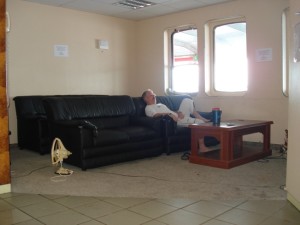
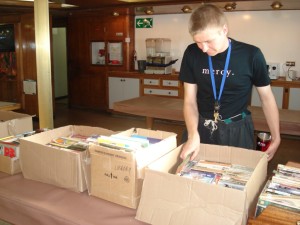
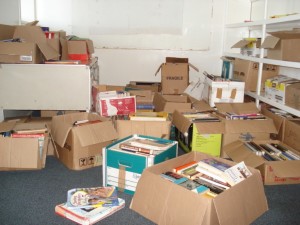
The oceans always seem to have the best sunrises and sunsets, and being out to sea gives you a prime opportunity to witness them. It seemed whenever the old ship was sailing, there was a handful of crew members on deck at every sunrise and sunset photographing the event, and this trip was no different. When the bible says, in Psalm 107;23-24, “They that go down to sea in ships, that do business in great waters, these have seen the works of the Lord-“, I’ve often wondered if its the sunsets and sunrises that the author was writing about. We saw many beautiful sunrises and sunsets all throughout the final sail. In addition, the weather was generally favorable to us for most of the trip, too- the only exceptions being a few rain showers & a few days of strong winds. The first morning, I went out on deck and saw a light out of the corner of my eye. I turned, wondering why the heck the sun was rising in the west instead of the west, only to realize that I was looking at the moon, bigger and brighter than I’d ever seen. I took a picture but it didn’t turn out that good. Pictures of such things never seem to turn out as you like, showing only a fraction of their beauty, whether its a sunrise, a sunset, or just ‘pretty clouds’. Who knows, maybe it’s just God’s way of reminding us to stop and marvel at His creation. These particular pictures don’t do justice to the many amazing sunrises and sunsets we saw while on this trip. Some of the colors were so rich & vivid it seemed like the sky itself had been set ablaze. Nonetheless, I hope you enjoy them. The constant time zone changes had us continually guessing when sunrise and sunset would be.
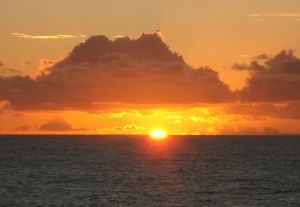
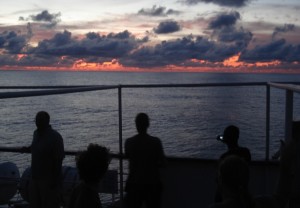
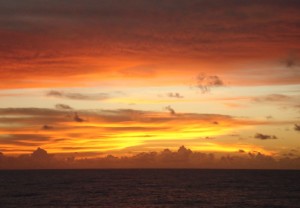
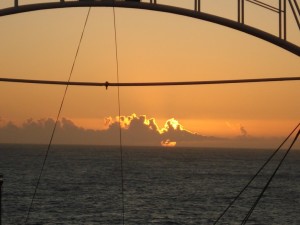
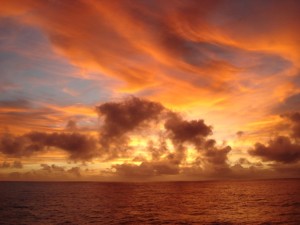
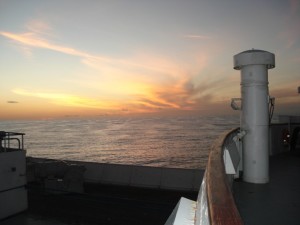
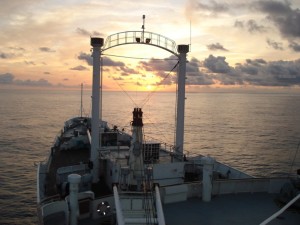
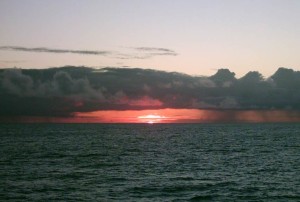
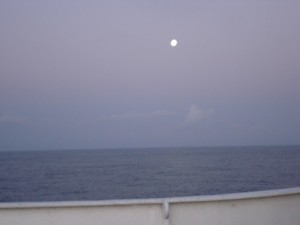
At around 1300 on July 7, we received a report of a distress call given about 18 hours south of us. It wasn’t far off
our course, and by 0700 the next morning we were at the last known location. The South African Coast Guard was
receiving hourly signals from an EPIRB, but it was unregistered & we had no way to know what kind of ship it was.
We’d all volunteered to stand lookout, but despite 8 hours of sweeping the area that the signal was coming from,
we saw no signs of any other ship having sunk other than a small oil slick & what looked like an old cardboard box floating around. At around 1500, we turned the ship back towards the southeast and continued on with our voyage.
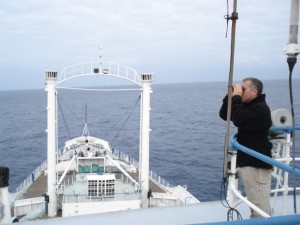
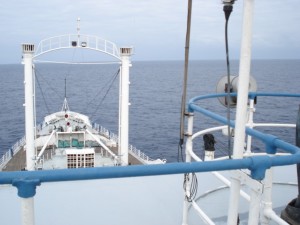
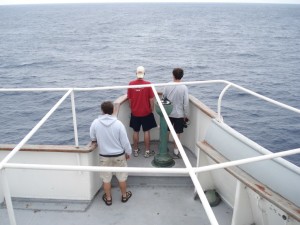
While we had planned on stopping in Durban, it became apparent we’d have to stop before that, so on June 14th,
just before dawn, we pulled into Cape Town. I hadn’t been there in two years, when I originally boarded the ship
at the V & A Waterfront in September of 2005. It was good to be back, though we were on the other side (and a
45-minute walk) from the V & A, where all the shops are. Nonetheless, at around 0800, Matt, Theo, and I headed
out the shipyard and to the road. We passed what is probably the largest dry-dock I’ve ever seen, large enough to
hold both ships (and maybe half of the CBM, as well!). We poked around the Victoria & Albert Waterfront for a
few hours, eating lunch, watching the street performers, checking our email at the internet cafe, and shopping for
all the folks back home. One by one, we all ran into each other, as everyone knew the V & A was the place to go.
We saw harbor seals, acrobats, street musicians, and who knows what else…a feast for the eyes, especially after
being at sea for a couple of weeks ( and being in West Africa for months before that! ). I even ran into Doug and
Katie Henderson, ex-crew members both and newly married. They’d happened to be surfing the web that morning and clicked over to Bowies website to see what he was up to. By funny coincidence, he’d just posted pictures of us coming into Cape Town on his website. Katie was shocked to see today’s date on the pictures and they raced down to the harbor to see where the old ship was. Our remote location behind a moored oil rig kept us hidden from them, so they strolled over to the V & A to see if they’d run into to someone they know. They caught me as I was getting into a cab, and we spent a half hour catching up. Good thing they saw me, I was one of only a half dozen crew members they’d remember. We all hoped the food, oil, fuel, parts, or new crewmember we were picking up in Cape Town would be delayed, but no such luck. We were ready to depart by early afternoon. The captain was gracious enough to grant us an extra few hours liberty. So, we were all back on board by 8 pm, & left soon after.
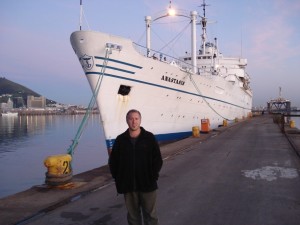
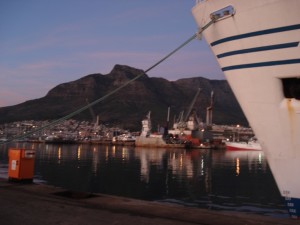
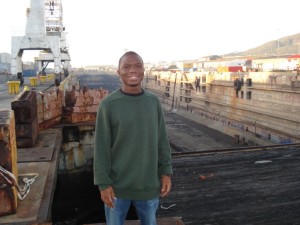
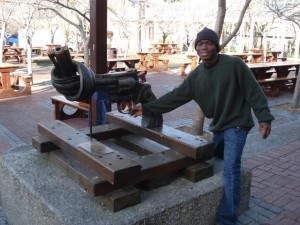
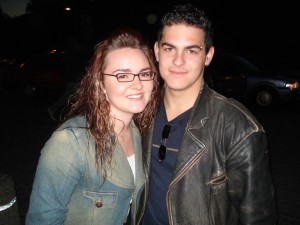
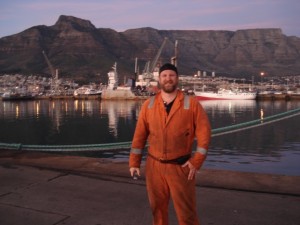
As exciting as the V & A Waterfront is, even that gets old after a few hours, and I wanted to pack as much in as I could. I rounded up some of the others and we headed over to Table Mountain. We were blessed with clear skies and good weather, and after a 5 minute cable car ride, we were on top. Ludovic, Micah, Theo, Bernard and I spent an hour on top of Table Mountain, seeing the sights and taking pictures. It wasn’t as thrilling as hike up the mountain I made two years ago, but it was still a welcome relief. The view was as stunning as I remember, and it was hard to leave. My only regret was not seeing any dossies this time around. Dassies (or hyraxes, as they’re officially known), are small rodent-like mammals that live on the mountain. They’re about the same size and shape as rabbits. they even look like rabbits minus the ears. Some of them are so used to tourists they’ll actually eat out your hand, and I saw no shortage of them last time I was here. There were at least three times the amount of tourists around this time, which most likely kept them away. If you look closely, you’ll see the ship hidden behind a 4-legged oil rig above & to the right of my left shoulder on the top right picture. As you can see, we’re quite a ways up from it, but believe it or not, the hand-held radio that I was carrying with me worked from all the way up on top of the mountain.
If we didn’t see dossies’, we saw plenty of other wildlife, starting with rats. Soon after our departure from Liberia, crewmembers began to see a couple of rats in the vicinity of the galley. We laid out some rat traps in the form of contact paper and waited. We never caught a rat, but we did snare a mouse one morning. We also managed to catch a baby seagull, who somehow got into the galley and went for the bacon I’d placed in the center of the paper. We saw plenty of the usuals, like pods of whales and dolphins, and no shortage of onboard pests like ants, spiders, lizards, and, of course, roaches. One day, some of the engineers found a young gannet floating around & fished it out of the water. It had run into some oil and it was a mess. It stayed on the aft deck for a few days, cleaning himself, seemingly oblivious to anyone who approached him. We brought him down to the riposto and tried to clean him up using several different cleaners and degreasers, but nothing seemed to do the trick. The most exciting creature we saw was a manta ray, which spent a few hours swimming around the stern while we were drifting. It’s markings were quite striking and it was a good sized ray, too- the wingspan (finspan?) was around three meters across. We all gathered on the aft deck and watched him go back and forth, looking to feed on the fish that were nibbling on our barnacles. You can see a two foot long remora on his back, as well. Finally, at bottom right there’s a picture of a long-haired, red-bearded Oregonian sapsucker onboard that showed up on the bridge twice a day, but spent most of it’s time hibernating. Long-haired red-bearded Oregonian sapsuckers are known for their booming laugh as well as their prodigious offspring.
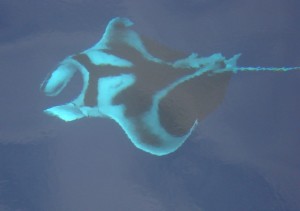
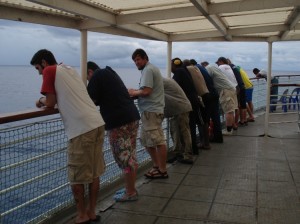
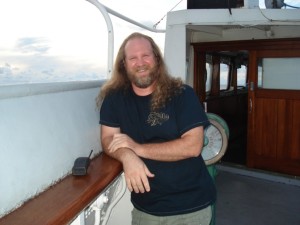
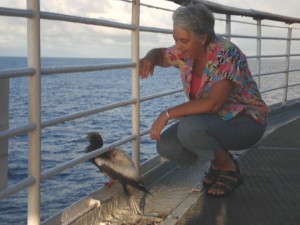
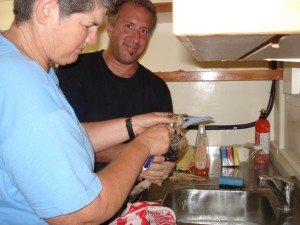
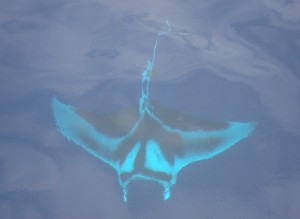
After leaving Cape Town, we received word that the ships purchaser would like a complete inventory of items on board. The list of items to be inventoried was pretty extensive, ranging from ‘nuts & bolts’ to miscellaneous scrap steel. So, we set about the task of counting every pillow, every tool, every piece of furniture, and, as you can see, every lifejacket. The engineers had their list, the electricians had theirs, and even the galley counted out every fork & spoon they had. Deck was responsible for everything that didn’t fall in those other categories, and it was a lot. Dan Connors & I spent two full weeks going over everything on the list, checking and rechecking rooms, offices, and storage spaces. Some of the items we collected together in the cabins for easy counting, such as the pillows and lifejackets. Inventorying the ship was like going back in a time machine. We found every sort of item, some going back decades. Photos of people we didn’t know, pictures of places we never went, echoes of outreaches we were never part of. Ghosts of the past spoke from every nook and corner, it seemed. We had fun poring over some of the old photos and promotional materials with those onboard who’d been with Mercy Ships for five years or more, as it invariably turned into a game of “Guess the Person/Port/Outreach”. They’d pass the pictures around to each other with comments like, “Yeah, he was a Dutch guy, worked in CDS-I think his name was Jan or Johan” or “I remember that sunken blue tugboat in the picture…which port was it that had the sunken blue tugboat? Lome? Freeport? Banjul?” We found pictures of people, places & things that they hadn’t though of in years. Many of the items we found were were useful, like tools, office supplies, and appliances. Bowie found a receiver from the 1970’s, attached it to one of the ships original speakers he salvaged and put together a decent radio, catching Indian radio stations from1500 kilometers away. When the signals faded, he rigged it to fit his MP3 player and had a ‘ghetto stereo’. Many items we found were too ancient to be of any value, and some were just bizarre, like the plastic chicken we found, normal on one side, but some sort of medical cut-away (with removable intestines, no less) on the other…used to teach ‘chicken anatomy’, I guess.
The part we had ordered never showed up in Cape Town, and we were forced to re-order it; to be picked up in Mauritius, about a week away. Nine days later, on the morning of July 23rd, we passed the southernmost island in the Seychelles chain, Reunion Island, just as the sun was coming up. We passed on the south side, which was comprised of wide sloping plains dotted with small white structures clumped into villages scattered here & there. It reminded me of the Aleutian Island chain in Alaska, or even the highlands of Scotland. Although we never got closer than six miles, we still had a beautiful view for the four hours it took to pass. Twelve hours later found us in Mauritius, the most well-known of the chain. While Reunion remains a protectorate of France, Mauritius is a country in it’s own right, consisting the large island of Mauritius and several smaller surrounding islands. Mauritius is a popular resort for Europeans and South Africans, known for high-end shops, expansive reefs scenic hiking up volcanic mountains, duty-free diamonds, and beautiful beaches…none of which we got to see, of course. Pressed for time, we weren’t able to dock and only planned to stay long enough to get the parts we needed. We came within a mile of the port and circled around for an hour, waiting for our parts to come out to us. We were close enough for those with mobiles to call home (or just text a quick greeting), but not close enough for those with laptops to get a wireless connection, as in Cape Town. I’d wanted to post this, but never got a chance to. At approximately 1830, a tug carrying our parts came out and we hauled them up in a bucket. After signing their receipt, we were on our way.
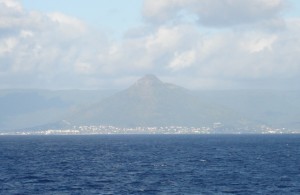
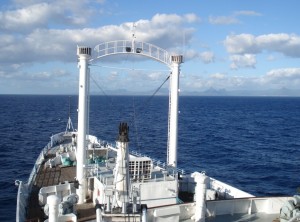
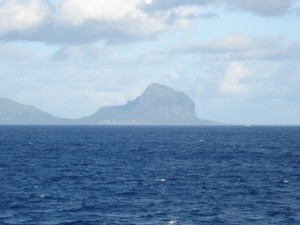
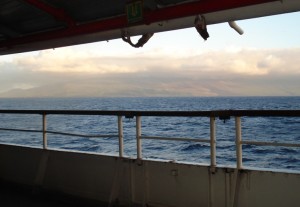
Before the ship served God as a ship of mercy, it was a ship of pleasure, sailing between Venice, Italy and Hong Kong. Known as the m/v Victoria back then, the ship belonged to the Italian cruise company Lloyd Trestino, along with it’s sister ships, the Asia, the Oceania, the Europa, and the Africa. Below, you can see some photos taken in the 1950’s and 1960’s, the era that it operated. I’ve taken some of the photos and put them alongside more recent pictures so you can see the comparison. Not all of these pictures are of the Victoria; many of them come from her sister ships I’ve named above. I’d thought about taking some pictures of some of the cabins then and now, but they don’t really look that much different….I’m sure that comes as no surprise to anyone who ever stayed in them.
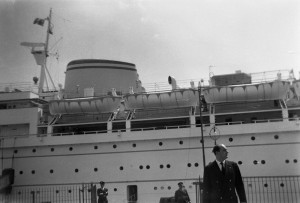 |
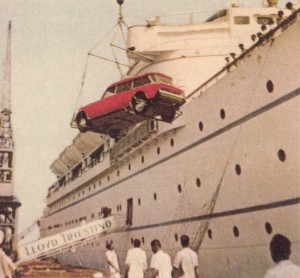 |
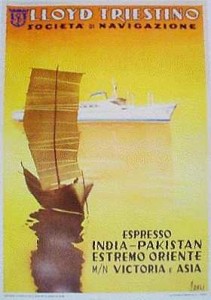 |
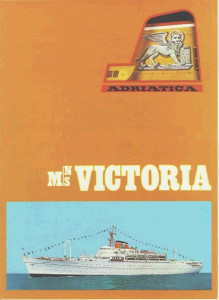 |
| Venice, 1961 | Unloading a Fiat | Old promotional materials | 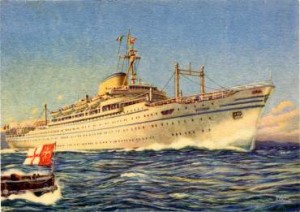 |
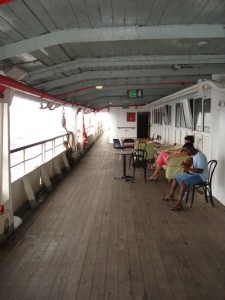 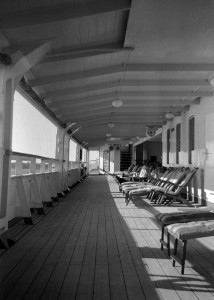 |
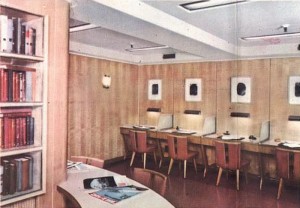 |
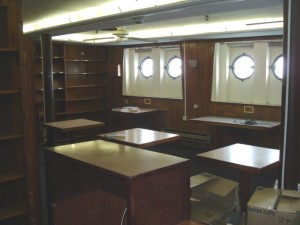 |
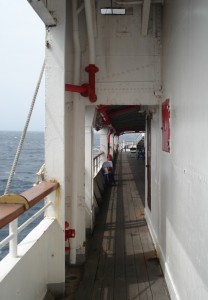 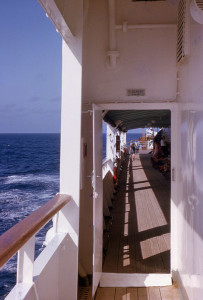 |
| Port Promenade Deck, looking forward | The Tourist-class ‘writing room’ | is now the library | Starboard Promenade Deck, looking aft |
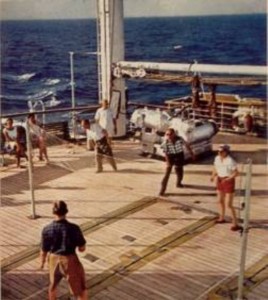 |
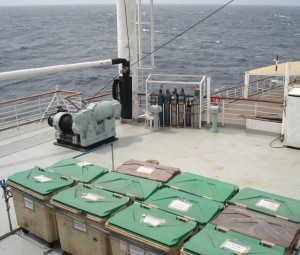 |
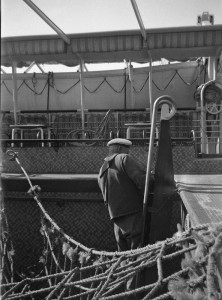 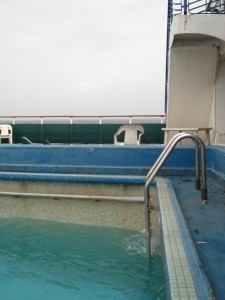 |
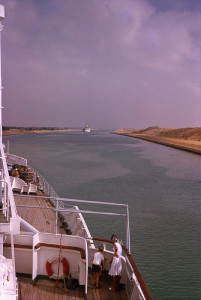 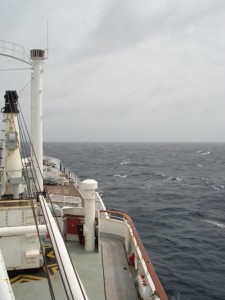 |
| Badminton on Hatch Four! | Hatch Four! | Pool (the lifeboats were removed in 2005) | Suez Canal, 1966 / Indian Ocean, 2007 |
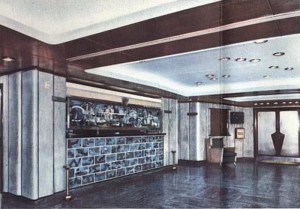 |
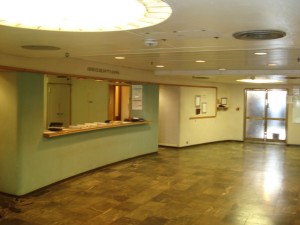 |
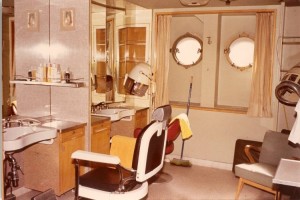 |
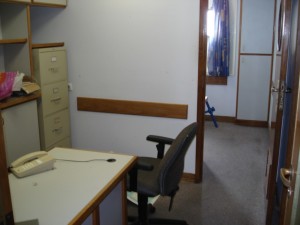 |
| Reception, then | Reception, now | Hair salon then | Operations Office now |
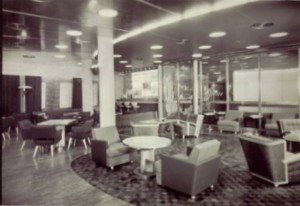 |
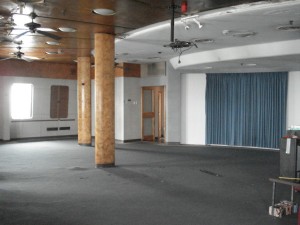 |
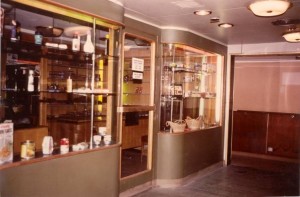 |
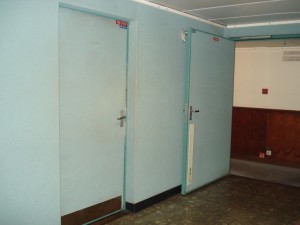 |
| First Class Lounge then | International Lounge now | The Gift Shop became our | Communications Office |
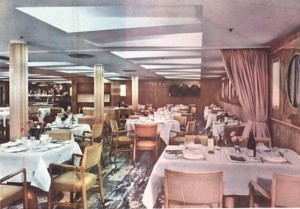 |
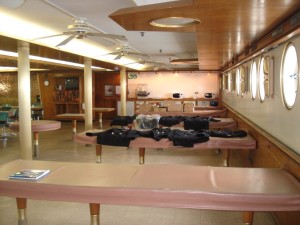 |
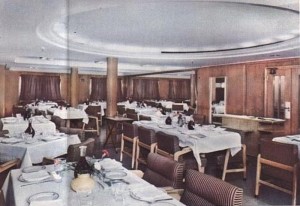 |
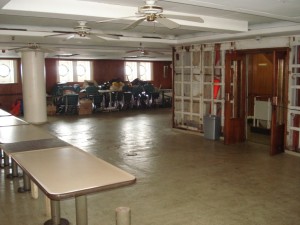 |
| First Class Dining Room | Forward Dining | Tourist Class Dining Room | Aft Dining, where the families ate. |
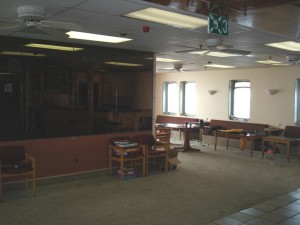 |
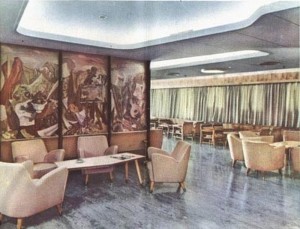 |
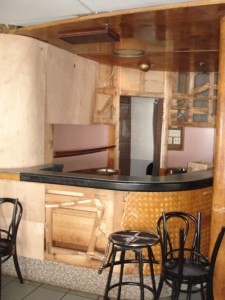 |
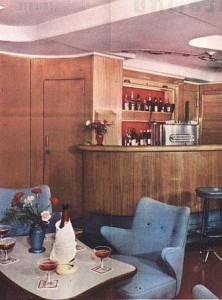 |
| What we call the Mediterranean Lounge | was once the Tourist Class Lounge |
What’s a sail without emergency drills? We had plenty of them, doing both a fire drill and an abandon ship drill every week for the duration of the sail. One week, Captain Jon even threw in a ‘grounding drill’, which consisted of checking the water depth at points around the waterline with a lead line, while simultaneously inspecting all of the cargo holds for incoming water, then simulating shoring up the breach we found. The way the machinery kept breaking down, the regular drills helped to keep us prepared for any eventuality.
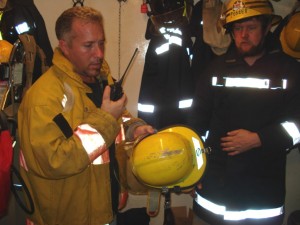
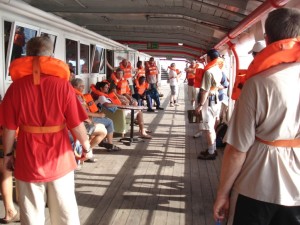
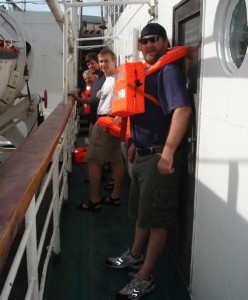
In addition to mealtimes, we gathered together regularly. Most Sunday afternoons, we had a weekly worship service on the port promenade deck, singing hymns out of the deck songbook, praying together for a safe passage (and our brothers and sisters on the Africa Mercy), and taking turns sharing the message. On the northbound leg of the voyage, as we neared the equator, we planned an ‘Equator Crossing Party’, but alas, continuing engine troubles left us adrift for another couple days. We turned it into a ‘Moonrise & Sunset Party’, complete with soft drinks, snacks & fellowship. We had it on the starboard bridge wing to be able to watch the sunset, but the ship’s drifting caused it to be on the port side. No matter, it’s a short walk. However, in the end it turned out to be a good choice on the date; that sunset turned out to be one of the nicest we would see the entire trip.
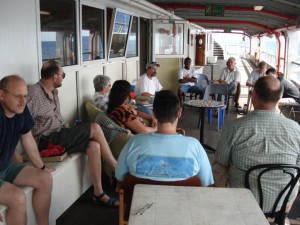
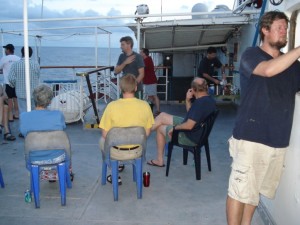
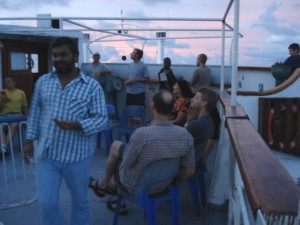
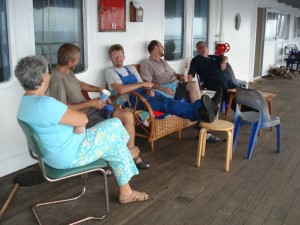
August 10- After 45 days and 8000+ miles, we pulled into our destination. The purchasers came aboard that evening to inspect the ship. We spent Saturday & Sunday ‘closing up shop’ and packing all suitcases. We boxed up all the materials that would be returning to the IOC and marked some of the larger items to to be shipped back. By Monday, we were ready to go and we began preparing for departure. It seems like the collective luggage of thirty-eight crew covered most of the promenade deck! Unfortunately, there was a slight delay in the purchase that caused us to be postponed for 24 hours, and we would have to spend one more day on the ship, and wouldn’t get to spend a day in Bhavanagar as we’d been hoping to. Still, if it’s one thing you learn in West Africa, it is ‘God’s Time Is Best’. We were now scheduled to leave the next day.
Final Thoughts- As melancholy as it was, it was a relief to depart the ship. What was intended as a one month trip had turned into over a month and a half, and we were ready to go. We had spent almost fifty days saying goodbye to the ship, and there was nothing left to say. We had spent a long while away from home, and we had wives, children and families waiting for us. Many had never been away from home for so long, and were eager to get back. Those of us returning to Liberia…not so much. But despite the desire to leave the ship, it was a bittersweet departure. There was much from this voyage we would miss. We would miss the beautiful sunrises and sunsets and all of the sea creatures we had witnessed this trip. We would miss the many quiet times we’d had alone, and the times we gathered to worship together. We would miss walking around once-noisy areas on a now silent ship, hearing the echoes of it’s past and we would miss the memories that were brought back, like ancient spirits that had been waiting to to be released from their resting places. We would miss the excitement of the the ships last, grand adventure and we would miss the small piece of history that thirty-eight of us had been so blessed to be a part of. We would miss the ‘Steve Wargo Dinner Hour’.
In our last worship a day before we left, we read from the book of Ecclesiastes, third chapter. It speaks of an appointed time for everything and a time for every affair under the heavens…a time to be born, a time to die. A time to seek, and a time to lose. This ship has served us for thirty years and served others in the twenty years before that. It would be no exaggeration to say this ship has seen all that Ecclesiastes speaks of. Weeping and laughter, rending and sewing, mourning and dancing, keeping and casting away, birth…and death. It has even seen it’s own resurrection, and bears the name of such. Now, there was only one time left,…one last step to take, one last chapter to write. And so, in the early evening of August 14th, the ships crew gathered their luggage, boarded the starboard lifeboats and headed for the beach…and the ship was laid to rest.
“This is not the end. It is not even the beginning of the end. It is, rather, the end of the beginning.”
-Winston Churchill
